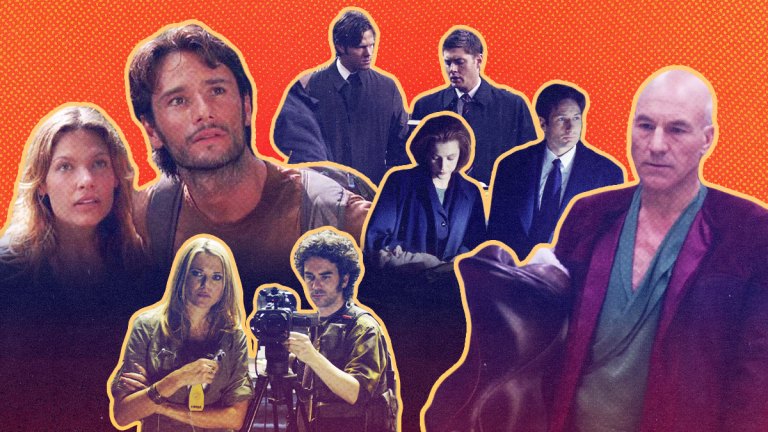The Best Filler TV Episode Tropes That Shorter Seasons Took From Us
"Filler" shouldn't be a dirty word when it comes to TV. Here are some episode tropes to remind you of why.

In the modern age of streaming and prestige TV, less is often considered more. A season of TV will be six, eight, or if you’re really lucky, 10 episodes long. It has been a bone of contention. During the recent writers’ strike, shorter seasons of streaming shows was one of the fields of conflict.
On the other hand, in a recent interview with CinemaBlend, Star Trek’s current head honcho Alex Kurtzman argued, “it’s funny you can talk to old writers of old Trek series, and they’re like, ‘Man, there’s a bunch of filler episodes in there. We are just trying to get to 22 a season,’ you know, and, and we all know which of those episodes were [filler], we know the ones that were truly stellar from the ones that felt like they were kind of spinning their wheels.”
A similar discussion has arisen as Lost has appeared on Netflix, with people arguing about which episodes you can safely skip. But these discussions ignore a key and important fact: The filler episodes are the best ones.
Forget your lore and your arcs and your show mythology, forget your season finales and your two-parters. The peak of the televisual arts is the episode where a room full of writers were starring in exhaustion at a list of 19 episode titles with three slots left to fill and no budget, and then decided to fall back on one of tried and true formats for the screenwriter who’s out of ideas.
This is what was taken from us.
Trapped in an Elevator
Classic Examples: Star Trek: The Next Generation “Disaster”, Community “Cooperative Calligraphy”, Parks and Recreation “Leslie and Ron”, Breaking Bad “The Fly” The X-Files “Ice”
Let’s start with the classic. Beloved by sitcoms (because it’s a situation you can get comedy out of) but a favorite for any writers room that is low on ideas and budget. Why not just get two or more characters – ideally ones who don’t get on – and then trap them somewhere for the full duration of an episode? Ideally somewhere that is one of your already standing sets!
These are often called “Bottle Episodes” (as in “Ship in a…”) but while bottle episodes use only the production’s standing sets, “Trapped in an Elevator” goes a step further and just locks the characters on that set and has nothing else happen.
The “Trapped in an Elevator” episode (it doesn’t have to be a lift) is not just a way to kill time and save money, however. If you’ve got an arc heavy storyline dropping lots of big events, these episodes are a good chance to slow the pace and just give your characters a chance to bounce off of each other for a bit.
What Happened Last Night?
Classic Examples: Star Trek: The Next Generation “Clues”, Red Dwarf “Thanks for the Memory”, Psych “Last Night Gus”, Elementary “For All You Know”, How I Met Your Mother “The Pineapple Incident”
You wake up. Your head is clanging. You don’t know where you are and you have a bunch of mysterious bruises and no memory of what happened the night before. We’ve all been there. But plenty of TV writers in a tight spot have used this as the inspiration for an entire episode (either that or they watched Dude! Where’s My Car? again), sending the characters on a mission to investigate themselves and find out just what they got up to the night before.
Lower Decks
Classic Examples: Star Trek: The Next Generation “Lower Decks”, CSI: Crime Scene Investigation “Lab Rats”, Lost “Expose”, Buffy the Vampire Slayer “The Zeppo”, Scrubs “Their Story”
This sub-genre of filler episode is not only a child of the 22-episode long TV season, but is also a relic of when series ran for far longer before getting a whack with the Cancel Hammer. You know the deal – you hire someone to play a lab assistant in season one. They do a good job so you bring them back again. Over time you feed them a few more lines, maybe even the occasional joke. Then suddenly, without warning, you have a fan favorite on your hands.
TNG’s “Lower Decks” is perhaps the most famous example of this, on account of inspiring a whole spinoff series, but CSI’s “Lab Rats” might be the peak of the format. It not only gives our favorite background lab coats center stage, but also acts as a handy clipshow/the story so far for people who’ve been losing track of the series’ ongoing dollhouse serial killer plotline.
Of course, the Lower Decks episode doesn’t have to feature a fan favorite. Lost’s “Expose” existed entirely to kill off two new characters the fans hated. But whatever the reason for the episode, it’s always good to see our lead cast from a perspective that doesn’t put them at the center of the universe.
Rashomon
Classic Examples: Farscape “The Ugly Truth”, Supernatural “Tall Tales”, Star Trek: The Next Generation “A Matter of Perspective”, The X-Files “Bad Blood”
That’s not how I remember it! Rashomon takes its name from the film Rashomon, in which three characters recount wildly different versions of the same sequence of events. As a filler episode tactic it’s dead clever because it allows you tell a story that fills only a fraction of an episode and then repeat it to fill the hour.
But it is also, like most of the filler episodes here, a great lens for character, allowing each person’s personality to color not only their telling of the story, but to show us how the rest of the cast looks from each person’s perspective.
The Documentary
Classic Examples: Battlestar Galactica “Final Cut”, The X-Files “X-Cops”, CSI: Crime Scene Investigation “I Like to Watch”, Community “Intermediate Documentary Filmmaking”
Another chance to get a different perspective on your characters as they’re going about their day to day business. It also gives you access to plot devices the TV episodes can’t normally use, as Abed points out in “Intermediate Documentary Filmmaking” – you can just have characters turn to the camera and say their feelings rather than having to demonstrate them through their actions!
Do a Die Hard
Classic Examples: Star Trek: The Next Generation “Starship Mine”, Star Trek: Voyager “Macrocosm” “Tinker, Tenor, Doctor, Spy”, Stargate Atlantis “The Storm” and “The Eye”, The Middleman “The Clotharian Contamination Protocol”, Buffy the Vampire Slayer “School Hard”, Alias “The Box”, CSI: NY “Snow Day”
If you’ve already done Trapped in an Elevator this season, there’s still a way to squeeze a few more drops of television from those standing sets. Why not have the baddies invade, take over and disable all but one or two of your cast? Then the one survivor character can crawl through the air ducts to take out the baddies one by one! It’s a fun way to showcase your character’s (perhaps unexpected) resourcefulness – especially if you cross it over with the “Lower Decks” format.
Amnesia? I Hardly Know Her!
Classic Examples: Buffy the Vampire Slayer “Tabula Rosa”, Angel “Spin the Bottle”, Star Trek: The Next Generation “Conundrum”
Memory loss is a serious medical condition that can take a number of complex forms, and can take years or possibly even forever to recover from. But also it’s a funny plot device that you can usually resolve within an hour (45 minutes if you don’t count the ad breaks).
And what can be more fun than giving what character amnesia? Why not give everyone amnesia? There’s only a small handful of examples of this episode format, two of them by the same writers, but it’s a great way to force the characters to take a fresh look at their own lives, and show the characters interacting with each other in new ways (by which we mean sex).
Time Loop Again
Classic Examples: The X-Files “Monday”, Star Trek: The Next Generation “Cause and Effect”, Supernatural “Mystery Spot”, Stargate SG-1 “Window of Opportunity”, Legends of Tomorrow “Here I Go Again”, Star Trek: Discovery “Magic to Make the Sanest Man Go Mad”
A Groundhog Day episode! As with the Rashomon Episode, this is a great excuse to reuse a lot of sets and costumes, and also allows the writers to get away with things they otherwise wouldn’t be able to – like killing off their main characters over and over and over again.
If your characters are actually aware of the time loop they are stuck in, it is also a chance to let them get away with things they otherwise wouldn’t be able to. Like playing minigolf through the stargate.
TV Show: The Movie!
Star Trek: Voyager “Living Witness” “Muse” “Author, Author”, Stargate SG-1 “Wormhole X-Treme!” “200”, The X-Files “Hollywood A.D.”, Supernatural “The Monster at the End of this Book” “The Real Ghostbusters”
The characters run into someone who creates a narrative of their adventures, but they’ve got the details all wrong! Have they got no respect for canon? If there is one thing a bored or mildly disgruntled writer’s room likes to do, it is break the fourth wall and get real meta with it. Sometimes it’s a book, a play, a TV series or a historical reenactment, but what it is mainly is a chance to crack jokes about the characters, the tropes the show itself uses, and of course the writers’ worst enemy – the audience.
Everyone Goes to Las Vegas For Some Reason
Classic Examples: Star Trek: Deep Space Nine “Badda-Bing Badda-Bang”, Angel “The House Always Wins”, Stargate Atlantis “Vegas”, The X-Files “Three of a Kind”, Friends “The One in Vegas”, Modern Family “Las Vegas”, Alias “The Coup”, Lexx “Viva Lexx Vegas”
This is possibly the peak of reusable episode formats. When all options have been tried, when all the ideas have been used up and the pizza in the writers’ room is well and truly cold, someone, at some point will finally say, “Screw it. Let’s do a Vegas episode.”
Taking your characters to an exotic location is a great way to shape things up, but for some reason out of all the places a TV show could visit, Las Vegas, Nevada, is top of the list. Maybe it’s the thrill of high stakes gambling, the story telling potential of all that flashy glamor so close to that seedy criminal underbelly. Maybe it’s that an awful lot of the attractions are indoors in windowless rooms that can be easily reconstructed on a soundstage. Who’s to say?
All we know for certain is that, if the show’s budget can handle the royalties, at some point there is going to be a chase scene across the casino floor to Elvis Presley’s “Viva Las Vegas.”
